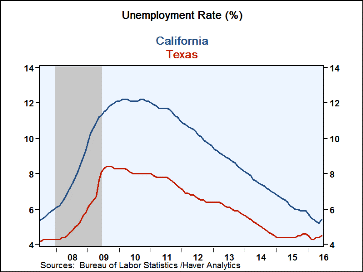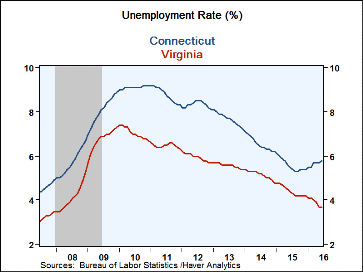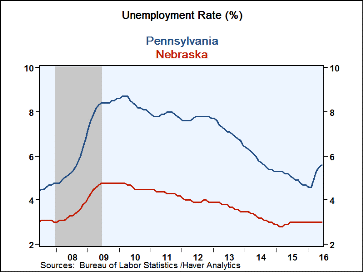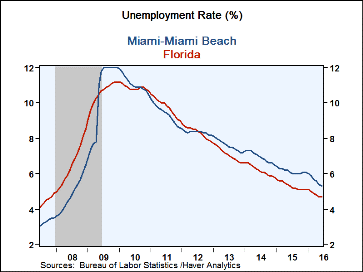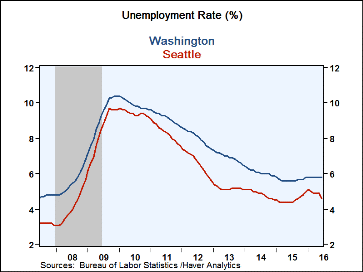 Global| Jul 22 2016
Global| Jul 22 2016U.S. State Unemployment Rates Vary from 2.7% to 6.7%
by:Tom Moeller
|in:Economy in Brief
Summary
The decline in the overall U.S. unemployment rate has stabilized this year, averaging 4.9% versus 5.3% during 2015. It still was half its late-2009 peak, and great variation amongst individual states continued. In today's state labor [...]
The decline in the overall U.S. unemployment rate has stabilized this year, averaging 4.9% versus 5.3% during 2015. It still was half its late-2009 peak, and great variation amongst individual states continued.
In today's state labor market report for June, unemployment in Alaska continued to top the chart at 6.7% versus 6.9% during all of last year. Unemployment in a few larger states, however, also was high. Illinois was high with a 6.2% unemployment rate, and a 6.4% average this year. That was higher than the 5.8% low during Q3'15. The 6.2% unemployment rate in Alabama also was elevated compared to other states, but has been stable since early last year. Moving northward, Pennsylvania's 5.6% jobless rate was elevated versus the 4.7% low averaged in Q4'15. Unemployment in California also remained high relative to the overall average, but its decline over to 5.4% from 6.4% one year ago has been steady.
Comparatively high unemployment rates also were logged in other large states, notably Georgia. Its 5.1% unemployment rate is down from roughly 6.0% early last year. New Jersey, however, has seen a different pattern develop. It's 5.1% jobless rate in June was low compared to other large states, but it has risen from 4.4% averaged in Q1'16. Ohio has seen a similar pattern develop as its 5.0% jobless rate was up versus 4.6% averaged in Q3'15.
At the low end of the scale, Iowa realized a 4.0% rate of unemployment, but that was up versus 3.6% averaged during all of last year. Continuing to decline, however, was unemployment in Virginia. It's 3.7% unemployment rate was down from 4.8% early last year. Colorado also recently realized a slight uptick in unemployment to 3.7% from a 3.0% low, but the decline in joblessness to 2.8% in New Hampshire has been fairly steady. Unemployment's decline to 2.7% in South Dakota also has been fairly steady.
In several large cities, unemployment hovers above the state average. That was true in Detroit where 5.1% unemployment was higher than 4.6% averaged in Michigan. Similarly, in New York City, its jobless rate of 5.0% was above the state's average of 4.7%. Miami's unemployment rate of 5.3% also was above the state's average of 4.7%. Working the other, however, was Washington state where the unemployment rate of 5.8% was above the Seattle metro area's of 4.6%.
State unemployment figures are available in Haver's EMPLR database.
| Jun | May | 2015 | 2014 | 2013 | Labor Force | |
|---|---|---|---|---|---|---|
|
Total U.S. Unemployment Rate |
4.9% | 4.7% | 5.3 | 6.2 | 7.4% | 158.9 million |
|
Ten States With Highest Jobless Rate |
||||||
| Alaska | 6.7 | 6.7 | 6.5 | 6.9 | 5.9 | 0.4 |
| Illinois | 6.2 | 6.4 | 5.9 | 7.0 | 8.9 | 6.7 |
| Louisiana | 6.2 | 6.3 | 6.2 | 6.3 | 6.5 | 2.2 |
| Alabama | 6.0 | 6.0 | 6.1 | 6.7 | 7.1 | 2.1 |
| Washington | 5.8 | 5.8 | 5.7 | 6.1 | 6.9 | 3.5 |
| Connecticut | 5.8 | 5.7 | 5.6 | 6.6 | 7.7 | 1.9 |
| Arizona | 5.8 | 5.6 | 6.1 | 6.7 | 7.5 | 3.0 |
| Pennsylvania | 5.6 | 5.5 | 5.0 | 5.8 | 7.1 | 6.4 |
| California | 5.4 | 5.2 | 6.3 | 7.5 | 8.8 | 19.0 |
| Georgia | 5.1 | 5.3 | 5.8 | 7.0 | 8.0 | 4.7 |
| Ten States With Lowest Jobless Rate | ||||||
| Iowa | 4.0 | 3.9 | 3.6 | 4.1 | 4.7 | 1.7 |
| Minnesota | 3.8 | 3.7 | 3.6 | 4.1 | 4.8 | 3.0 |
| Arkansas | 3.8 | 3.8 | 5.2 | 6.0 | 7.2 | 1.4 |
| Virginia | 3.7 | 3.7 | 4.4 | 5.1 | 5.6 | 4.2 |
| Idaho | 3.7 | 3.7 | 4.1 | 4.8 | 6.1 | 0.8 |
| Maine | 3.7 | 3.5 | 4.4 | 5.6 | 6.6 | 0.7 |
| Colorado | 3.7 | 3.3 | 3.8 | 4.9 | 6.7 | 2.8 |
| Nebraska | 3.0 | 3.0 | 2.9 | 3.2 | 3.7 | 1.0 |
| New Hampshire | 2.8 | 2.7 | 3.4 | 4.3 | 5.1 | 0.7 |
| South Dakota | 2.7 | 2.5 | 3.1 | 3.4 | 3.8 | 0.5 |
| Jobless Rate In Other Selected Large States | ||||||
| New Jersey | 5.1 | 4.9 | 5.6 | 6.7 | 8.1 | 4.5 |
| Ohio | 5.0 | 5.1 | 4.8 | 5.7 | 7.3 | 5.7 |
| North Carolina | 4.9 | 5.1 | 5.7 | 6.2 | 7.8 | 4.8 |
| New York | 4.7 | 4.7 | 5.3 | 6.3 | 7.5 | 9.6 |
| Michigan | 4.6 | 4.7 | 5.4 | 7.1 | 8.5 | 4.7 |
| Florida | 4.7 | 4.7 | 5.3 | 6.1 | 7.0 | 9.6 |
| Texas | 4.5 | 4.4 | 4.5 | 5.0 | 6.1 | 13.0 |
| Wisconsin | 4.2 | 4.2 | 4.6 | 5.4 | 6.6 | 3.1 |
| Massachusetts | 4.2 | 4.2 | 4.9 | 5.7 | 6.6 | 3.6 |
Tom Moeller
AuthorMore in Author Profile »Prior to joining Haver Analytics in 2000, Mr. Moeller worked as the Economist at Chancellor Capital Management from 1985 to 1999. There, he developed comprehensive economic forecasts and interpreted economic data for equity and fixed income portfolio managers. Also at Chancellor, Mr. Moeller worked as an equity analyst and was responsible for researching and rating companies in the economically sensitive automobile and housing industries for investment in Chancellor’s equity portfolio. Prior to joining Chancellor, Mr. Moeller was an Economist at Citibank from 1979 to 1984. He also analyzed pricing behavior in the metals industry for the Council on Wage and Price Stability in Washington, D.C. In 1999, Mr. Moeller received the award for most accurate forecast from the Forecasters' Club of New York. From 1990 to 1992 he was President of the New York Association for Business Economists. Mr. Moeller earned an M.B.A. in Finance from Fordham University, where he graduated in 1987. He holds a Bachelor of Arts in Economics from George Washington University.


